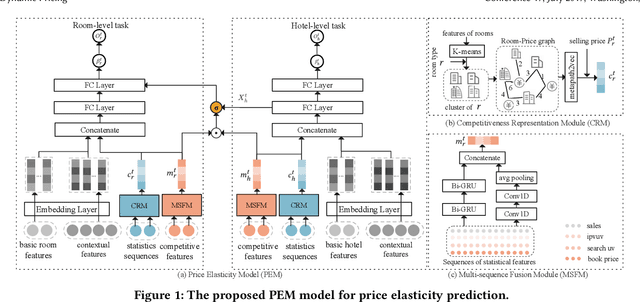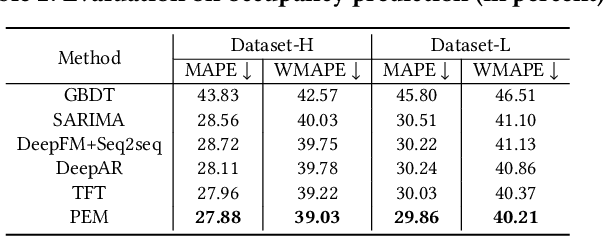Zulong Chen
Addressing Information Loss and Interaction Collapse: A Dual Enhanced Attention Framework for Feature Interaction
Mar 14, 2025Abstract:The Transformer has proven to be a significant approach in feature interaction for CTR prediction, achieving considerable success in previous works. However, it also presents potential challenges in handling feature interactions. Firstly, Transformers may encounter information loss when capturing feature interactions. By relying on inner products to represent pairwise relationships, they compress raw interaction information, which can result in a degradation of fidelity. Secondly, due to the long-tail features distribution, feature fields with low information-abundance embeddings constrain the information abundance of other fields, leading to collapsed embedding matrices. To tackle these issues, we propose a Dual Attention Framework for Enhanced Feature Interaction, known as Dual Enhanced Attention. This framework integrates two attention mechanisms: the Combo-ID attention mechanism and the collapse-avoiding attention mechanism. The Combo-ID attention mechanism directly retains feature interaction pairs to mitigate information loss, while the collapse-avoiding attention mechanism adaptively filters out low information-abundance interaction pairs to prevent interaction collapse. Extensive experiments conducted on industrial datasets have shown the effectiveness of Dual Enhanced Attention.
Hierarchical Causal Transformer with Heterogeneous Information for Expandable Sequential Recommendation
Mar 04, 2025Abstract:Sequential recommendation systems leveraging transformer architectures have demonstrated exceptional capabilities in capturing user behavior patterns. At the core of these systems lies the critical challenge of constructing effective item representations. Traditional approaches employ feature fusion through simple concatenation or basic neural architectures to create uniform representation sequences. However, these conventional methods fail to address the intrinsic diversity of item attributes, thereby constraining the transformer's capacity to discern fine-grained patterns and hindering model extensibility. Although recent research has begun incorporating user-related heterogeneous features into item sequences, the equally crucial item-side heterogeneous feature continue to be neglected. To bridge this methodological gap, we present HeterRec - an innovative framework featuring two novel components: the Heterogeneous Token Flattening Layer (HTFL) and Hierarchical Causal Transformer (HCT). HTFL pioneers a sophisticated tokenization mechanism that decomposes items into multi-dimensional token sets and structures them into heterogeneous sequences, enabling scalable performance enhancement through model expansion. The HCT architecture further enhances pattern discovery through token-level and item-level attention mechanisms. furthermore, we develop a Listwise Multi-step Prediction (LMP) objective function to optimize learning process. Rigorous validation, including real-world industrial platforms, confirms HeterRec's state-of-the-art performance in both effective and efficiency.
Efficient Long Sequential Low-rank Adaptive Attention for Click-through rate Prediction
Mar 04, 2025Abstract:In the context of burgeoning user historical behavior data, Accurate click-through rate(CTR) prediction requires effective modeling of lengthy user behavior sequences. As the volume of such data keeps swelling, the focus of research has shifted towards developing effective long-term behavior modeling methods to capture latent user interests. Nevertheless, the complexity introduced by large scale data brings about computational hurdles. There is a pressing need to strike a balance between achieving high model performance and meeting the strict response time requirements of online services. While existing retrieval-based methods (e.g., similarity filtering or attention approximation) achieve practical runtime efficiency, they inherently compromise information fidelity through aggressive sequence truncation or attention sparsification. This paper presents a novel attention mechanism. It overcomes the shortcomings of existing methods while ensuring computational efficiency. This mechanism learn compressed representation of sequence with length $L$ via low-rank projection matrices (rank $r \ll L$), reducing attention complexity from $O(L)$ to $O(r)$. It also integrates a uniquely designed loss function to preserve nonlinearity of attention. In the inference stage, the mechanism adopts matrix absorption and prestorage strategies. These strategies enable it to effectively satisfy online constraints. Comprehensive offline and online experiments demonstrate that the proposed method outperforms current state-of-the-art solutions.
Think Thrice Before You Act: Progressive Thought Refinement in Large Language Models
Oct 17, 2024Abstract:Recent advancements in large language models (LLMs) have demonstrated that progressive refinement, rather than providing a single answer, results in more accurate and thoughtful outputs. However, existing methods often rely heavily on supervision signals to evaluate previous responses, making it difficult to assess output quality in more open-ended scenarios effectively. Additionally, these methods are typically designed for specific tasks, which limits their generalization to new domains. To address these limitations, we propose Progressive Thought Refinement (PTR), a framework that enables LLMs to refine their responses progressively. PTR operates in two phases: (1) Thought data construction stage: We propose a weak and strong model collaborative selection strategy to build a high-quality progressive refinement dataset to ensure logical consistency from thought to answers, and the answers are gradually refined in each round. (2) Thought-Mask Fine-Tuning Phase: We design a training structure to mask the "thought" and adjust loss weights to encourage LLMs to refine prior thought, teaching them to implicitly understand "how to improve" rather than "what is correct." Experimental results show that PTR significantly enhances LLM performance across ten diverse tasks (avg. from 49.6% to 53.5%) without task-specific fine-tuning. Notably, in more open-ended tasks, LLMs also demonstrate substantial improvements in the quality of responses beyond mere accuracy, suggesting that PTR truly teaches LLMs to self-improve over time.
Retrieval-style In-Context Learning for Few-shot Hierarchical Text Classification
Jun 25, 2024Abstract:Hierarchical text classification (HTC) is an important task with broad applications, while few-shot HTC has gained increasing interest recently. While in-context learning (ICL) with large language models (LLMs) has achieved significant success in few-shot learning, it is not as effective for HTC because of the expansive hierarchical label sets and extremely-ambiguous labels. In this work, we introduce the first ICL-based framework with LLM for few-shot HTC. We exploit a retrieval database to identify relevant demonstrations, and an iterative policy to manage multi-layer hierarchical labels. Particularly, we equip the retrieval database with HTC label-aware representations for the input texts, which is achieved by continual training on a pretrained language model with masked language modeling (MLM), layer-wise classification (CLS, specifically for HTC), and a novel divergent contrastive learning (DCL, mainly for adjacent semantically-similar labels) objective. Experimental results on three benchmark datasets demonstrate superior performance of our method, and we can achieve state-of-the-art results in few-shot HTC.
Exploring User Retrieval Integration towards Large Language Models for Cross-Domain Sequential Recommendation
Jun 05, 2024Abstract:Cross-Domain Sequential Recommendation (CDSR) aims to mine and transfer users' sequential preferences across different domains to alleviate the long-standing cold-start issue. Traditional CDSR models capture collaborative information through user and item modeling while overlooking valuable semantic information. Recently, Large Language Model (LLM) has demonstrated powerful semantic reasoning capabilities, motivating us to introduce them to better capture semantic information. However, introducing LLMs to CDSR is non-trivial due to two crucial issues: seamless information integration and domain-specific generation. To this end, we propose a novel framework named URLLM, which aims to improve the CDSR performance by exploring the User Retrieval approach and domain grounding on LLM simultaneously. Specifically, we first present a novel dual-graph sequential model to capture the diverse information, along with an alignment and contrastive learning method to facilitate domain knowledge transfer. Subsequently, a user retrieve-generation model is adopted to seamlessly integrate the structural information into LLM, fully harnessing its emergent inferencing ability. Furthermore, we propose a domain-specific strategy and a refinement module to prevent out-of-domain generation. Extensive experiments on Amazon demonstrated the information integration and domain-specific generation ability of URLLM in comparison to state-of-the-art baselines. Our code is available at https://github.com/TingJShen/URLLM
AutoCrawler: A Progressive Understanding Web Agent for Web Crawler Generation
Apr 19, 2024



Abstract:Web automation is a significant technique that accomplishes complicated web tasks by automating common web actions, enhancing operational efficiency, and reducing the need for manual intervention. Traditional methods, such as wrappers, suffer from limited adaptability and scalability when faced with a new website. On the other hand, generative agents empowered by large language models (LLMs) exhibit poor performance and reusability in open-world scenarios. In this work, we introduce a crawler generation task for vertical information web pages and the paradigm of combining LLMs with crawlers, which helps crawlers handle diverse and changing web environments more efficiently. We propose AutoCrawler, a two-stage framework that leverages the hierarchical structure of HTML for progressive understanding. Through top-down and step-back operations, AutoCrawler can learn from erroneous actions and continuously prune HTML for better action generation. We conduct comprehensive experiments with multiple LLMs and demonstrate the effectiveness of our framework. Resources of this paper can be found at \url{https://github.com/EZ-hwh/AutoCrawler}
Character is Destiny: Can Large Language Models Simulate Persona-Driven Decisions in Role-Playing?
Apr 18, 2024



Abstract:Can Large Language Models substitute humans in making important decisions? Recent research has unveiled the potential of LLMs to role-play assigned personas, mimicking their knowledge and linguistic habits. However, imitative decision-making requires a more nuanced understanding of personas. In this paper, we benchmark the ability of LLMs in persona-driven decision-making. Specifically, we investigate whether LLMs can predict characters' decisions provided with the preceding stories in high-quality novels. Leveraging character analyses written by literary experts, we construct a dataset LIFECHOICE comprising 1,401 character decision points from 395 books. Then, we conduct comprehensive experiments on LIFECHOICE, with various LLMs and methods for LLM role-playing. The results demonstrate that state-of-the-art LLMs exhibit promising capabilities in this task, yet there is substantial room for improvement. Hence, we further propose the CHARMAP method, which achieves a 6.01% increase in accuracy via persona-based memory retrieval. We will make our datasets and code publicly available.
Modeling User Viewing Flow using Large Language Models for Article Recommendation
Nov 12, 2023Abstract:This paper proposes the User Viewing Flow Modeling (SINGLE) method for the article recommendation task, which models the user constant preference and instant interest from user-clicked articles. Specifically, we employ a user constant viewing flow modeling method to summarize the user's general interest to recommend articles. We utilize Large Language Models (LLMs) to capture constant user preferences from previously clicked articles, such as skills and positions. Then we design the user instant viewing flow modeling method to build interactions between user-clicked article history and candidate articles. It attentively reads the representations of user-clicked articles and aims to learn the user's different interest views to match the candidate article. Our experimental results on the Alibaba Technology Association (ATA) website show the advantage of SINGLE, which achieves 2.4% improvements over previous baseline models in the online A/B test. Our further analyses illustrate that SINGLE has the ability to build a more tailored recommendation system by mimicking different article viewing behaviors of users and recommending more appropriate and diverse articles to match user interests.
Modeling Price Elasticity for Occupancy Prediction in Hotel Dynamic Pricing
Aug 11, 2022



Abstract:Demand estimation plays an important role in dynamic pricing where the optimal price can be obtained via maximizing the revenue based on the demand curve. In online hotel booking platform, the demand or occupancy of rooms varies across room-types and changes over time, and thus it is challenging to get an accurate occupancy estimate. In this paper, we propose a novel hotel demand function that explicitly models the price elasticity of demand for occupancy prediction, and design a price elasticity prediction model to learn the dynamic price elasticity coefficient from a variety of affecting factors. Our model is composed of carefully designed elasticity learning modules to alleviate the endogeneity problem, and trained in a multi-task framework to tackle the data sparseness. We conduct comprehensive experiments on real-world datasets and validate the superiority of our method over the state-of-the-art baselines for both occupancy prediction and dynamic pricing.
 Add to Chrome
Add to Chrome Add to Firefox
Add to Firefox Add to Edge
Add to Edge